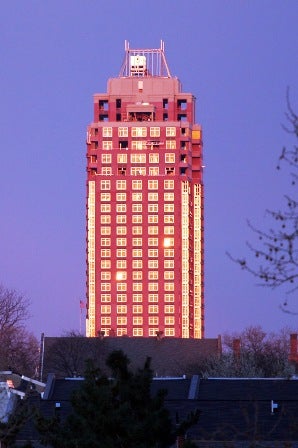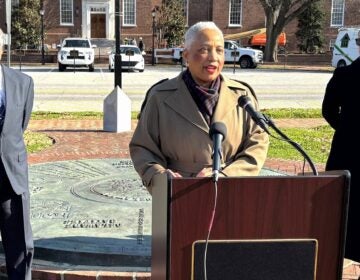Wednesday roundup: Dranoff fires back

Brad Maule photo
Oct. 31
Last week, Inquirer architecture critic Inga Saffron critiqued the design of Carl Dranoff’s newly unveiled Symphony House on Broad Street.
Here is an excerpt:
“Except to those who resolutely averted their eyes during construction, it won’t come as news that Symphony House is the ugliest new condo building in Philadelphia. The 32-story mixed-use tower flounces onto venerable South Broad Street like a sequined and over-rouged strumpet. Sheathed in a sickly shade of pink concrete, the building resembles, as one blogger wittily observed, a giant Pepto-Bismol bottle. If only it were possible to look away!”
Today, The Inquirer published a letter to the editor from Dranoff in response to Saffron’s column:
Letters | Taking Exception
Defending a beautiful building
I awoke this morning to discover that my company had joined the ranks of some of the greatest architects and developers in America who have been criticized by Inquirer architecture critic Inga Saffron (“Nightmare on Broad Street,” Oct. 26).
Many great buildings, including our own City Hall and Art Museum, faced severe criticism when first unveiled, but Saffron’s review of Symphony House went beyond criticism. It was a one-sided, mean-spirited, malicious rant.
Am I to imagine that all of the many sophisticated buyers at Symphony House have bad taste? Should I assume that the zoning officials, the Philadelphia Industrial Development Corp. selections committee, our neighbors along the Avenue of the Arts, our governor, senators, mayor and other high-placed civic officials who have called the project “visionary,” “brilliant” and “magnificent” also all have bad taste?
Saffron gives no credit whatsoever to a daring plan which made possible the Suzanne Roberts Theatre, two wonderful ground-level restaurants and a grand 32-story structure that fits perfectly next to its neighbors. She gives no credit to the quality of materials and attention to details inside and out, which has so impressed virtually all. Instead, she dwells on minor details like the incredibly beautiful exterior wall sconces being a different finish than window frames.
A project like Symphony House, which has completely transformed South Broad Street and especially the pedestrian-level experience of this previously deserted block, should be applauded as a civic undertaking that brought about virtually an entire new gateway to the Avenue of the Arts.
I am a veteran Philadelphia developer who was born here and have spent my life here, and I have built a reputation over 25 years for developing projects with quality and imagination. We are proud of our track record and the integrity we bring to our business. Above all, we are proud of Symphony House, which is timeless and has contributed so much already to the richness and variety of the Avenue of the Arts.
By attacking those who have praised its design and importance upon the avenue, Saffron misses the fundamental intent of urban design: Buildings are designed for people, not for critics.
Carl E. Dranoff
Founder and CEO
Dranoff Properties
Philadelphia
In other news:
With the public presentation set for Nov. 14th, Philadelphia Daily News Editorial Page Editor Sandra Shea lauds the civic engagement aspect of the PennPraxis Delaware Waterfront visioning process.
***
And check out Ryan Briggs’ column in the Temple News.
***
The Daily Pennsylvanian reports about the impact traffic congestion, parking and lack of pedestrian access may have on the Cira South development.
***
Last week:
SugarHouse Casino representatives filed a lawsuit enjoining Philadelphia City Council and the Philadelphia City Planning Commission, claiming that the city has unfairly delayed the proposed casino’s development.
The state courts have already ruled that the city has no say concerning where casinos are located within its boundaries, according to the the suit which was filed in Pennsylvania Supreme Court.
SugarHouse wants the court to order the city to take action on the casino’s applications and implement the Gaming Control Board ruling that said SugarHouse could build at its proposed site.
Casino officials also want City Council to “suspend any Council rule that would cause further delay” and create a Commercial Entertainment District – essentially the physical place where zoning would allow a gaming facility.
SugarHouse wants the court to state that the city has a “mandatory duty to timely review all applications for permits submitted by HSP Gaming and to issue all building, zoning and use permits for which HSP Gaming’s applications satisfy the requirements and procedures of the CED Ordinance.”
The Philadelphia Neighborhood Alliance – the group of neighborhood associations that was previously the Delaware River Neighborhood Alliance – issued a statement calling the lawsuit “desperate.”
“Council members, by supporting and protecting the interests and well-being of their constituents — the residents of Philadelphia – are simply doing the job for which they were elected by the citizens of Philadelphia,” the statement says, and SugarHouse has encountered obstacles because of “massive community opposition.”
Foxwoods, the other casino proposed for Philadelphia, has also filed a lawsuit asking the state supreme court to override the city’s authority and grant the zoning necessary for them to build on their parcel.
***
The 6abc mayoral debate between Michael Nutter and Al Taubenberger included references to the Penn Praxis Central Delaware Waterfront visioning, the zoning code reform that is under way and the need for a comprehensive long-range look at planning and development in Philadelphia.
On the broadcast, moderator Jim Gardner mentions extending the street grid. In the context of zoning he says that some think it’s terrific, some think it’s terrible:
http://abclocal.go.com/wpvi/story?section=politics&id=5721597
Go to time: 41:39.
Nutter talks generally about planning and zoning reform, and about the missed opportunities on the waterfront for last 40 years. He says there should be long-term, comprehensive plans for the city, and we should have the greatest waterfront in the country.
***
Wednesday, Inquirer reporter Jennifer Lin details the public debate over the soon-to-be-released Penn Praxis waterfront visioning exercise that encompasses seven miles of the Central Delaware Riverfront.
***
On Monday, The Inquirer looked at the long-term and short-term work going on in rethinking the Central Delaware Waterfront. The paper published an editorial endorsing long-range goals by PennPraxis as well as a quick fix in terms of public access to the water’s edge by Center City District chief Paul Levy.
***
Check out the Daily Pennsylvanian: Penn Praxis director Harris Steinberg calls for the creation of a comprehensive transportation, open space and land use strategy for Philadelphia.
WHYY is your source for fact-based, in-depth journalism and information. As a nonprofit organization, we rely on financial support from readers like you. Please give today.






